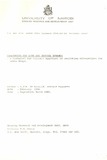Sanitation For Site And Service Schemes
Abstract
The recent national census which revealed that Kenya's population
shot up by 50 percent. over the last decade has caused a lot
of concern to the country's planners and has underlined the clear
need for an urgent review of present planning methodologies.
Kenya's annual growth rate of 3.9 percent is one of the highest
if not the highest figure in the world. Over the remaining
years of this century capital resources will be strained to the
limits, reflecting the economic and social move towards
industralisation. Natural population increase in the urban areas
combined with rural-urban migration will exacerbate an already
deteriorating housing situation. Particularly, the growth of
families in the low-income bracket (K.Shs.200 - K.Shs.l,400
monthly) will become a serious liability for urban councils.
Official house construction for the low income population has
always been a meagre percentage of actual needs. Therefore, the
current trend of the Kenyan Government is to move away from
actual house building to the provision of services only. The
current implementation of site and service schemes and squatter
upgrading programmes reftect this trend.
In the sanitation field, it is becoming clear, that conventional
sewerage is both too costly and frequently inappropriate for the
situation.
This study will try to identify some of the possible alternatives.
Publisher
University Of Nairobi
Subject
Sanitation For Site And ServiceRights
Attribution-NonCommercial-NoDerivs 3.0 United StatesUsage Rights
http://creativecommons.org/licenses/by-nc-nd/3.0/us/Collections
- Research Reports [210]
The following license files are associated with this item:


